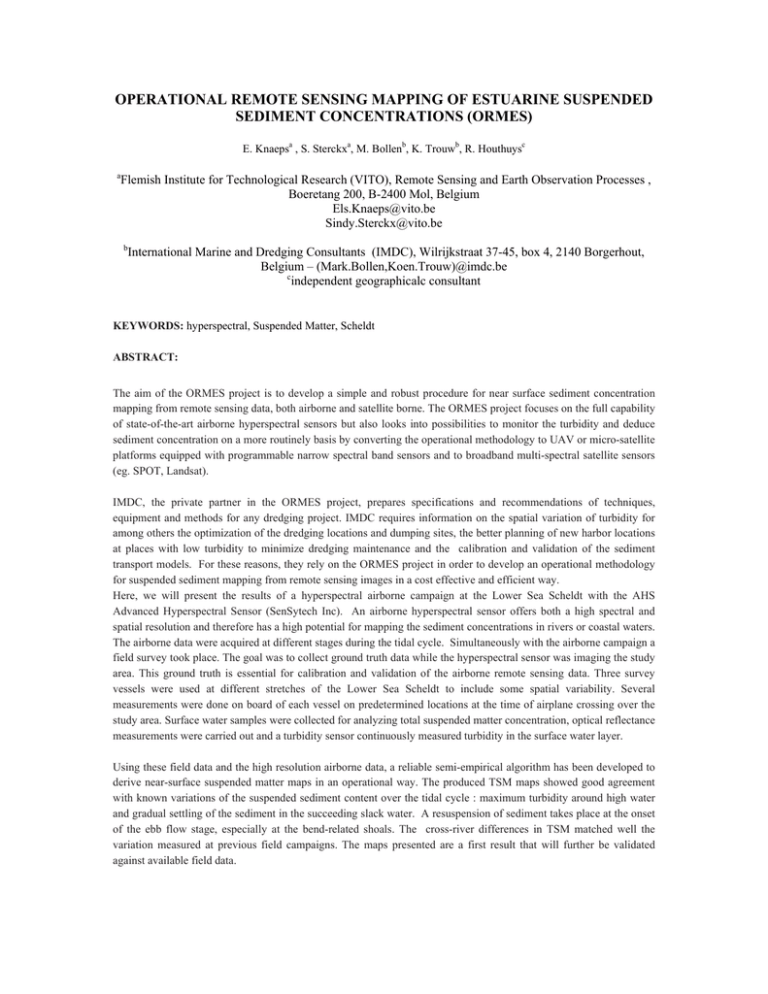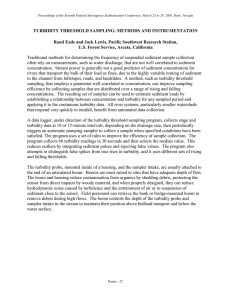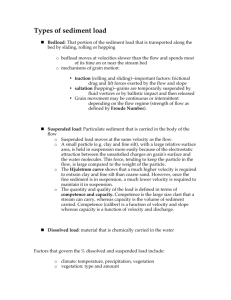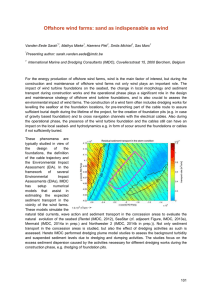OPERATIONAL REMOTE SENSING MAPPING OF ESTUARINE SUSPENDED SEDIMENT CONCENTRATIONS (ORMES)
advertisement

OPERATIONAL REMOTE SENSING MAPPING OF ESTUARINE SUSPENDED SEDIMENT CONCENTRATIONS (ORMES) E. Knaepsa , S. Sterckxa, M. Bollenb, K. Trouwb, R. Houthuysc a Flemish Institute for Technological Research (VITO), Remote Sensing and Earth Observation Processes , Boeretang 200, B-2400 Mol, Belgium Els.Knaeps@vito.be Sindy.Sterckx@vito.be b International Marine and Dredging Consultants (IMDC), Wilrijkstraat 37-45, box 4, 2140 Borgerhout, Belgium – (Mark.Bollen,Koen.Trouw)@imdc.be c independent geographicalc consultant KEYWORDS: hyperspectral, Suspended Matter, Scheldt ABSTRACT: The aim of the ORMES project is to develop a simple and robust procedure for near surface sediment concentration mapping from remote sensing data, both airborne and satellite borne. The ORMES project focuses on the full capability of state-of-the-art airborne hyperspectral sensors but also looks into possibilities to monitor the turbidity and deduce sediment concentration on a more routinely basis by converting the operational methodology to UAV or micro-satellite platforms equipped with programmable narrow spectral band sensors and to broadband multi-spectral satellite sensors (eg. SPOT, Landsat). IMDC, the private partner in the ORMES project, prepares specifications and recommendations of techniques, equipment and methods for any dredging project. IMDC requires information on the spatial variation of turbidity for among others the optimization of the dredging locations and dumping sites, the better planning of new harbor locations at places with low turbidity to minimize dredging maintenance and the calibration and validation of the sediment transport models. For these reasons, they rely on the ORMES project in order to develop an operational methodology for suspended sediment mapping from remote sensing images in a cost effective and efficient way. Here, we will present the results of a hyperspectral airborne campaign at the Lower Sea Scheldt with the AHS Advanced Hyperspectral Sensor (SenSytech Inc). An airborne hyperspectral sensor offers both a high spectral and spatial resolution and therefore has a high potential for mapping the sediment concentrations in rivers or coastal waters. The airborne data were acquired at different stages during the tidal cycle. Simultaneously with the airborne campaign a field survey took place. The goal was to collect ground truth data while the hyperspectral sensor was imaging the study area. This ground truth is essential for calibration and validation of the airborne remote sensing data. Three survey vessels were used at different stretches of the Lower Sea Scheldt to include some spatial variability. Several measurements were done on board of each vessel on predetermined locations at the time of airplane crossing over the study area. Surface water samples were collected for analyzing total suspended matter concentration, optical reflectance measurements were carried out and a turbidity sensor continuously measured turbidity in the surface water layer. Using these field data and the high resolution airborne data, a reliable semi-empirical algorithm has been developed to derive near-surface suspended matter maps in an operational way. The produced TSM maps showed good agreement with known variations of the suspended sediment content over the tidal cycle : maximum turbidity around high water and gradual settling of the sediment in the succeeding slack water. A resuspension of sediment takes place at the onset of the ebb flow stage, especially at the bend-related shoals. The cross-river differences in TSM matched well the variation measured at previous field campaigns. The maps presented are a first result that will further be validated against available field data.





